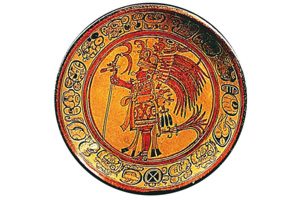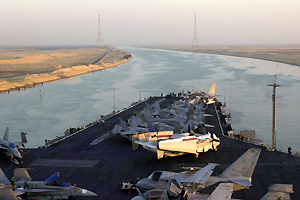Little is known concerning the history of the Aztecs or Mexicas before their arrival to the Mexico valley during the XII and XIII centuries.
Once they were established in this zone, they found many tribes, suffering numerous adversities, reason why they decided to refuge and settle themselves in the islets to the west of the Texcoco lake (where Mexico City is located today). Since this place offered optimum conditions for settling (good provision of water and food), they raised their capital, Tenochtitlán (1325). At the beginning, this settlement was only a small village made up of fishermen and farmers, but slowly its inhabitants started to absorb the practices and knowledge of the tlatelolcas (a neighboring tribe) which helped them become the focus of what would later become one of the greatest empires of America.
Towards the Triple Alliance
Under the reign of Izcóatl (1428-1440) an accelerated race started towards the cultural and territorial expansion of the Aztec civilization. This governor military defeated the kingdom of Tepaneca, founding a social and political structure which characterized the empire: The Triple Alliance.
This union was composed by three urban centers: Tenochtitlán, Texcoco and Tlacopán. However, the power was exerted in Tenochtitlán.
In 1440, the year of the death of Izcóatl, the alliance extended its hegemony beyond the Mexico valley.
Since then, five rulers or tlatoanis succeeded him: Moctezuma I, Axayácatl, Tizoc, Auitzotl and Moctezuma II. All of them achieved the conquest of a great part of the Mesoamerican territory, even the Maya regions of Central America.
On the 8th of november of 1519, the Spanish conquerors, headed by Hernán Cortés, arrived to Tenochtitlán, establishing friendly relationships with their emperor, Moctezuma II. However, the successive lootings against the natives generated an uprising against the Spanish, which was restrained with bloody massacres. Finally, on the 13th of august of 1521, the Aztec empire was subjugated by force.
Cultures of the Central Andes
From Ecuador to the north of Chile and southwest of Bolivia, highly evolved cultures developed since 1000 b.C. Highlighted among these cultures, were the Chavín, Parakas, Vicús, Recuay, Moche, Nasca, Tiwanaku, Wari, Mayta-Chiribaya, Sicán Lambayeque, Chimú, Chancay and Inca.
Most of these civilizations implemented a very complex agriculture, even the sowing and cultivating on arid zones, in despite of not having plows or wheels.
Likewise, they stood out for their majestic constructions (temples and pyramids) and for the beauty of their textiles, ceramics and delicate jewels made out of metal and stone.
In this issue, we will only profoundly speak about the Incas, since they imposed themselves above all the other pre-Columbian civilizations of the central Andes, even reaching Chilean territory.
The Incas, lords of Cuzco
The origin and the great part of the historical development of the Incas (or Inkas) is still a mystery for the specialists. It is only known that, in a century and from the sacred city of Cuzco, they developed a powerful empire, which controlled almost completely the south of pre-Hispanic America. At present, these territories correspond to Colombia, Ecuador, Peru, the north of Chile, Bolivia and Argentina.
In its beginnings, the Inca civilization was constituted by a series of families coming from the surroundings of the Titicaca lake who were governed by a chieftain denominated Inca (hence the name of this civilization).
Once they were established in Cuzco, they inaugurated a dynasty whose first king was Manco Cápac (the legend says that he was the founder of the race).
The following dynasties succeeded in small reigns until 1438 a.C. when Pachacutec Inca Yupanqui defeated his fierce enemies, the Chancas. This event marked the birth of the Tawantinsuyo or Tawantinsuyu, that is to say, The Inca empire.
The third horizon
The stage that marked the consolidation of the Tawantinsuyo has been denominated by the archeologists as the third horizon. It was characterized because great conquests came to pass consisting first in peacefully establishing settlements near the civilizations that they wanted to rule, and then, through the use of gifts, convince them to come into the empire. If this strategy did not work, war was declared. In the third horizon, an architectural and artistic style was also imposed given the customs and traditions of each conquered place.
This stage was initiated towards 1463 a.C. when Pachacutec (who governed between 1438 and 1463) appointed as heir his son Túpac Inca Yupanqui, who started one of the most brilliant military campaigns. This way, between 1471 and 1493, the Tawatinsuyo reached its maximum splendor as the entire zone of the Andean high plains was dominated.
In addition, the northern regions of Argentina and Chile, Quito (Ecuador) and the inhabitants of the kingdom of Chimu (coast of Peru) were integrated. Also during their reign, great constructions were erected, like the fortress of Sacsayhuaman and the palaces of Chinchero.
Tupac Inca Yupanqui’s successor was his son, Huayna Capac. The only people he couldn’t dominate were the Mapuches (south of Chile) and the Amazonian tribes to the east. This was not due to a lack of military power, it was because the aforementioned civilizations were only hunters and gatherers, and therefore they were unimportant to the Incas.
The end of the empire
After the death of Huayna Capac, this civilization fell into the hands of his sons: Huascar and Atahualpa.
The first took charge of the southern part of the empire, while the second was given the northern region. However, soon tensions between the brothers translated into a war for total control of the empire.
The confrontation between Huascar and Atahualpa coincided with the arrival of the Spanish conquerors to Incan territory, under the command of Francisco Pizarro (1531). Having heard about the struggle between heirs, he took advantage of the situation for his own benefit. For this reason, he captured Atahualpa (November of 1532), who, while in prison, ordered the death of Huascar to that way keep the throne. He also agreed to give Pizarro gold for his release. However, although Atahualpa kept his end of the plan, Pizarro had him executed (1533).
After this event, the Spanish conqueror designated Manco Capac II as emperor. Despite this, the Spanish had already begun to sack the city, causing the definite disappearance of this empire (1572).
The Mayas, a developed culture
Although the origin of the Maya civilization is not exactly known, it is believed that they are descendants of the inhabitants who came from Asia to America through the Bering Strait (between Alaska and Siberia).
The Maya civilization was composed by a series of ethnical and linguistic groups, including the Huastecas, the Tzotzil-maya and the Tzotzil. These communities established themselves in a vast zone which corresponds to certain sectors of the current territories of Mexico, Belize, El Salvador, Honduras, Nicaragua and Guatemala.
The territory occupied by the Mayas presented very different geographical characteristics, divided in three main zones: the north, composed by vast and arid planes; the south, which presented a stable climate and abundance of vegetation, and the central, which was covered by a dense tropical jungle. Each one of these regions represented a specific moment of the history of this culture.
Formative or Preclassical period
This stage, which had its geographical epicenter in the highlands of the south, started between the year 2000 and 1500 b.C. and ended in 300 a.C.
It would have specifically initiated in the coast of the Gulf of Mexico and under the influence of the Olmeca civilization, known as the mother culture of Mesoamerica, since it was the first in establishing a set of social standards, religious concepts, aesthetic ideas in its art and architecture, etc.
In this stage, the Mayas built their first villages and religious centers around the squares mainly utilizing clay, stone and wood, thus establishing this as the model that they would later use to erect their cities.
The inhabitants of these cities practiced a primitive agriculture (cultivation of corn and tuber such as potatoes and cassava), fishing and vegetable and wild fruit harvesting. In addition, they worked with jade stone, with which they made small figures that they carried as an ornament on their bodies and worked with ceramics, especially, the monochrome jugs. The main demographical nucleuses were the cities of Uaxactún, La Victoria and Tikal. This last one was considered the oldest capital of the Maya civilization.
Classical Period
The six centuries of the classical period took place in the vast central zone of the Mayan territory, which correspond to the greatest years of this civilization (from 300 to 900 a.C.).
At the beginning, the inhabitants were still located in the region of El Petén, where the cities of Uaxactún and Tikal were found. Later, during the IV century, they began an important territorial expansion, such as Palenque, Piedras Negras, Copán, Uxmal, Bonampak and Sayil.
All these cities reached their maximum cultural splendor between 600 and 850 a.C., leaving notable remnants in the temples of Tikal, Palenque and Copán. Highlighted among these, is a great quantity of steles with hieroglyphic engravings and polychrome figurative ceramic, with feline representations.
At the end of the year 850, as a result of the long droughts, the main Maya cities started to economically decline, which generated the displacement of their inhabitants towards unexploited regions.
Post-classical Period
Between the X and XVI centuries, the Mayas conquered new lands in the north zone, specifically in the Yucatán peninsula, reorganizing their city-states. The main city states were: Chichén Itzá (which kept its hegemony from 950 until 1200 a.C.) and Mayapán.
This last one was destroyed in the middle of the XV century, causing the division of the political and commercial power in 17 cacicazgos or independent rival provinces, although some of these formed alliances. This situation favored the conquest of the Spanish (between 1527 and 1536) and the final twilight of the Maya civilization.
Before the encounter of two worlds
In the Mesoamerican region (a great part of Mexico and some zones of Central America or intermediate or middle America) some civilizations emerged between 2000 and 1500 b.C. such as the Chupícuaros, the Colimas, the Guerreros, the Mixtecas, the Olmecs, the Teotihuacanos, the Mayas and the Aztecs. All theses groups had similar aspects such as their agriculture and science practices, and a theocratic kind of government.
In this section, we will talk about two of the great Mesoamerican civilizations – the Maya and the Aztecs-, who had an independent development and a high level of evolution.
– The Mayas, a developed culture
– The Aztecs, a great empire
- Cultures of the Central Andes
- The Incas, lords of Cuzco








